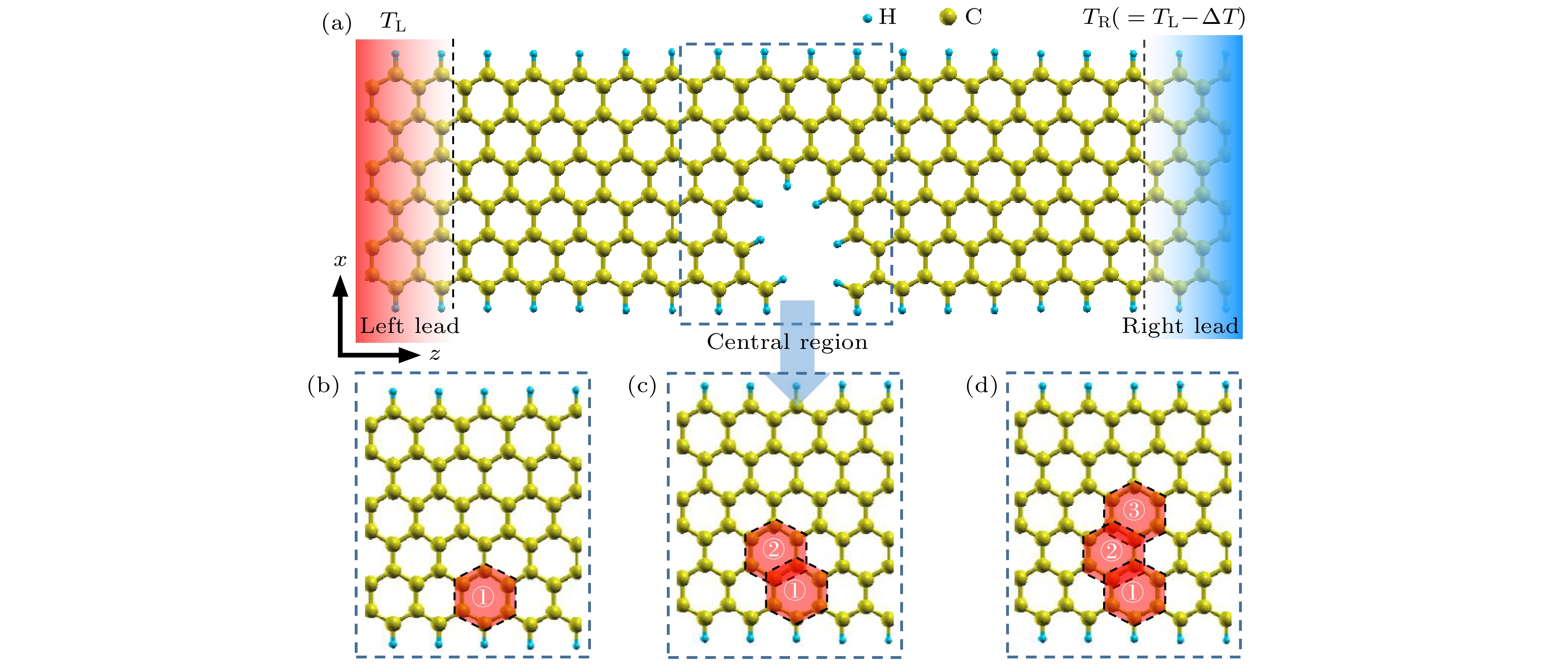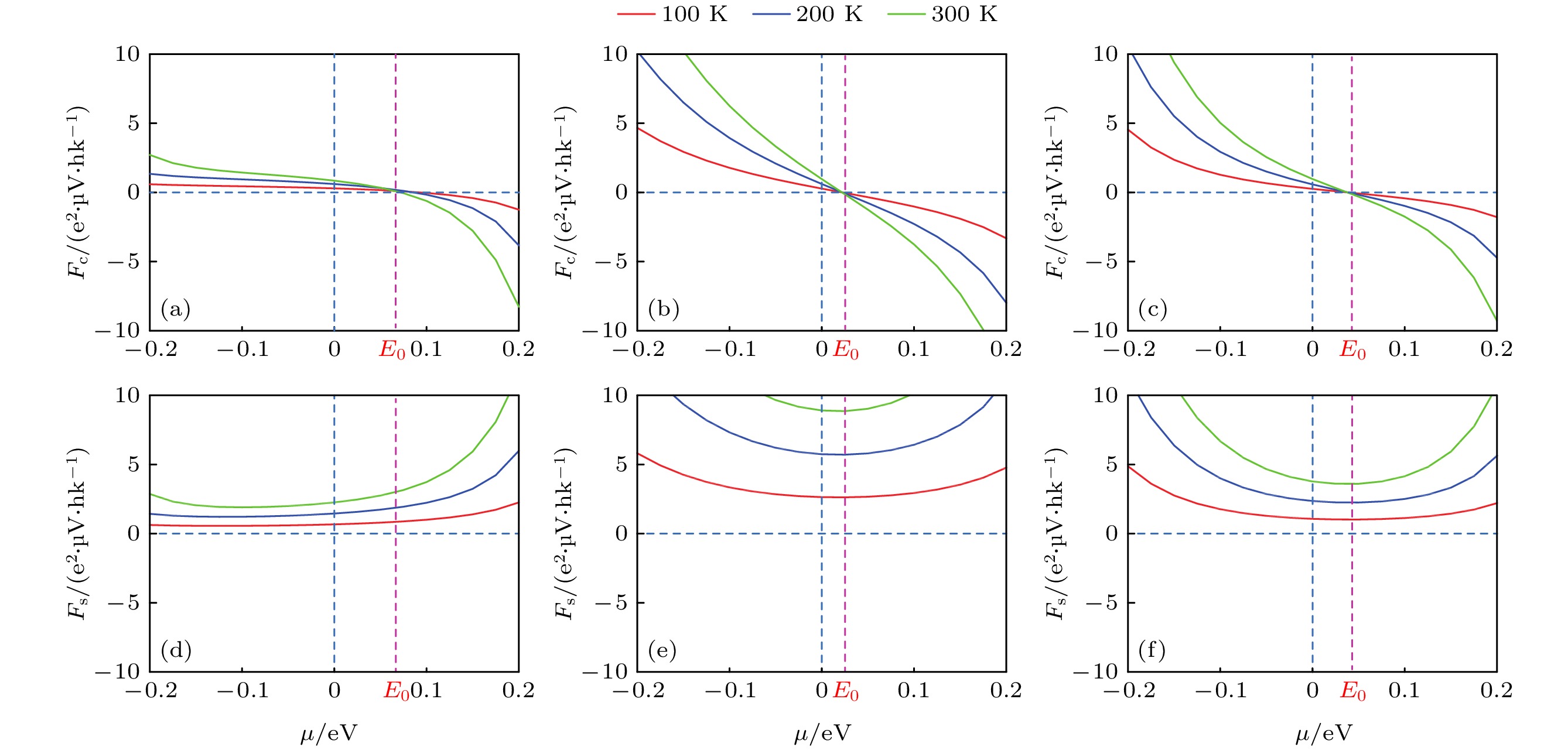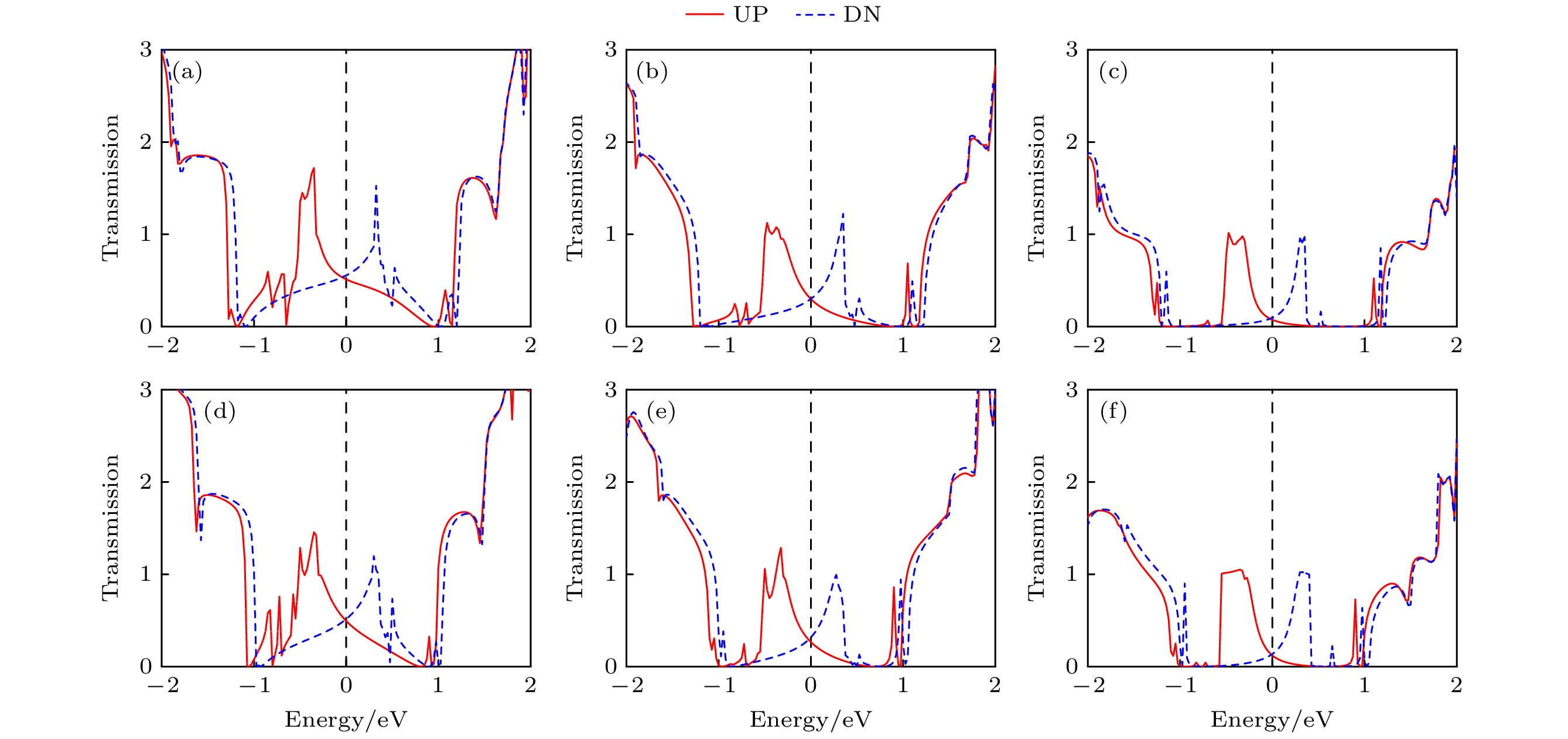-
热自旋电子学结合了热电子学和自旋电子学二者的优势, 在构建高速、低能耗器件技术上具有广泛的应用前景. 本文基于密度泛函理论和非平衡格林函数相结合的方法, 研究了在铁磁态石墨烯纳米带中沿带宽方向引入连续反量子点(六元环缺陷)以获得纯自旋流的模型. 计算发现, 在纳米带的单边引入反量子点会破坏纳米带结构的完整性, 导致器件的透射谱在费米能级附近呈现“X”形交叉. 在温度场下, 不同自旋的电子朝相反方向流动, 形成了自旋流和电荷流, 并且通过微调器件的化学势可以获得电荷流为0, 自旋流不为0的纯自旋流. 结果表明, 对于具有W条链宽的锯齿型石墨烯纳米带, 当沿纳米带带宽方向连续引入反量子点数满足(W/2–1)时, 即可获得最大的纯自旋流, 这一研究结果为设计基于石墨烯纳米带的纯自旋流器件提供了有力的理论依据.Spin caloritronics, which combines the characteristics of thermoelectronics with the characteristics of spintronics, has a wide range of promising applications in high-speed and low-dissipation devices. In this paper, according to the density functional theory combined with nonequilibrium Green’s function method, we propose a scheme for generating pure spin current with spin dependent Seebeck effect in the zigzag-edged graphene nanoribbons by introducing continuous antidots (hexagonal defects). Specifically, by creating an antidot at one edge of the nanoribbon, an X-shape transmission spectrum around the Fermi level is formed, which results from the disrupted edge of the nanoribbon. The mechanism is well explained by the cooperation between the varying localization features of the eigenstates around the Fermi level for the unit cell and the scattering states at the Fermi level for the device. Therefore, the electrons of the two spin channels flow in the opposite directions under a temperature gradient, generating the spin current and charge current. By slightly tuning the chemical potential of the device, the charge current can be zero, while the spin current is not equal to zero. With the increase of adjacent antidot number along the width of the nanoribbons, the structures are more disrupted, thus promoting the pure spin current due to the increase of the spin Seebeck coefficient. However, for zigzag graphene nanoribbons with W zigzag carbon chains, the pure spin current decreases when the number of the antidots are more than (W/2–1), which results from the decrease of the spin conductance. So, the maximum pure spin current can be obtained when the number of the continuous antidots introduced along the width of nanoribbons reaches (W/2–1). These findings indicate a novel strategy for thermally generating the spin current by introducing continuous antidots along the nanoribbon bandwidth in zigzag graphene nanoribbons and will be greatly instructive in designing the graphene spintronic devices.
-
Keywords:
- spin caloritronics /
- antidot /
- pure spin current /
- density functional theory
[1] Wolf S A, Awschalom D D, Buhrman R A, Daughton J M, von Molnár S, Roukes M L, Chtchelkanova A Y, Treger D M 2001 Science 294 1488
 Google Scholar
Google Scholar
[2] Awschalom D D, Flatté M E 2007 Nat. Phys. 3 153
 Google Scholar
Google Scholar
[3] Mishchenko E G, Shytov A V, Halperin B I 2004 Phys. Rev. Lett. 93 226602
 Google Scholar
Google Scholar
[4] Tao X, Hao H, Wang X, Zheng X, Zeng Z 2016 Appl. Phys. Lett. 108 233106
 Google Scholar
Google Scholar
[5] Qing F, Sun X, Xie C 2005 Phys. Rev. B 72 245305
 Google Scholar
Google Scholar
[6] Hirsch J E 1999 Phys. Rev. Lett. 83 1834
 Google Scholar
Google Scholar
[7] Mucciolo E R, Chamon C, Marcus C M 2002 Phys. Rev. Lett. 89 146802
 Google Scholar
Google Scholar
[8] Hübner J, Rühle W W, Klude M, Hommel D, Bhat R D R, Sipe J E., Van Driel H M 2003 Phys. Rev. Lett. 90 216601
 Google Scholar
Google Scholar
[9] Ma Z, Wu R L, Yu Y B, Wang M 2014 J. Appl. Phys. 116 043706
 Google Scholar
Google Scholar
[10] Jiang P, Tao X, Hao H, Song L, Zheng X, Zhang L, Zeng Z 2017 2 D Mater. 4 035001
 Google Scholar
Google Scholar
[11] Novoselov K S, Geim A K, Morozov S V, Jiang D, Zhang Y, Dubonos S V, Grigorieva I V 2004 Science 306 666
 Google Scholar
Google Scholar
[12] Novoselov K S 2011 Rev. Mod. Phys. 83 837
 Google Scholar
Google Scholar
[13] Geim A K 2011 Rev. Mod. Phys. 83 851
 Google Scholar
Google Scholar
[14] Min S K, Kim W Y, Cho Y, Kim K S 2011 Nat. Nanotechnol. 6 162
 Google Scholar
Google Scholar
[15] Yazyev O V, Katsnelson M I 2008 Phys. Rev. Lett. 100 047209
 Google Scholar
Google Scholar
[16] Son Y W, Cohen M L, Louie S G 2006 Nature 444 347
 Google Scholar
Google Scholar
[17] Dutta S, Manna A K, Pati S K 2009 Phys. Rev. Lett. 102 096601
 Google Scholar
Google Scholar
[18] Tao X, Zhang L, Zheng X, Hao H, Wang X, Song L, Zeng Z, Guo H 2018 Nanoscale 10 174
 Google Scholar
Google Scholar
[19] Zhang Y T, Jiang H, Sun Q F, Xie X C 2010 Phys. Rev. B 81 165404
 Google Scholar
Google Scholar
[20] Wang Z F, Liu F 2011 Appl. Phys. Lett. 99 042110
 Google Scholar
Google Scholar
[21] Zhou Y, Zheng X 2019 J. Phys. Condes. Matter 31 315301
 Google Scholar
Google Scholar
[22] Song L, Jin S, Liu Y, Yuan L, Yang Z, Jiang P, Zheng X 2020 Physica E 115 113684
 Google Scholar
Google Scholar
[23] Liu X B, Kou Z K, Mu S C 2015 Prog. Chem. 27 1566
[24] Fischbein M D, Drndic M 2008 Appl. Phys. Lett. 93 113107
 Google Scholar
Google Scholar
[25] Liu J, Cai H, Yu X X, Zhang K 2012 J. Phys. Chem. C 116 15741
 Google Scholar
Google Scholar
[26] Safron N S, Kim M, Gopalan P, Arnold M S 2012 Adv. Mater. 24 1041
 Google Scholar
Google Scholar
[27] Yan Y, Liang Q, Zhao H, Wu Q, Li B 2012 Phys. Lett. A 376 2425
 Google Scholar
Google Scholar
[28] Song L L, Zheng X H, Wang R L, Zeng Z 2010 J. Phys. Chem. C 114 12145
 Google Scholar
Google Scholar
[29] Zhang X, Yazyev O V, Feng J, Xie L, Tao C, Chen Y C, Jiao L, Pedramrazi Z, Zettl A, Louie S, Dai H, Dai H 2013 ACS Nano 7 198
 Google Scholar
Google Scholar
[30] Soler J M, Artacho E, Gale J D, García A, Junquera J, Ordejón P, Sánchez-Portal D 2002 J. Phys. Condens. Matter 14 2745
 Google Scholar
Google Scholar
[31] Taylor J, Guo H, Wang J 2001 Phys. Rev. B 63 245407
 Google Scholar
Google Scholar
[32] Perdew J P, Burke K, Ernzerhof M 1996 Phys. Rev. Lett. 77 3865
 Google Scholar
Google Scholar
[33] Rejec T, Ramšak A, Jefferson J H 2002 Phys. Rev. B 65 235301
 Google Scholar
Google Scholar
[34] Proetto C R 1991 Phys. Rev. B 44 9096
 Google Scholar
Google Scholar
-
图 4 (a) N1, (b) N2, (c) N3模型在100 K下的自旋塞贝克系数; (d) N1, (e) N2, (f) N3模型在200 K下的自旋塞贝克系数; (g) N1, (h) N2, (i) N3模型在300 K下的自旋塞贝克系数
Fig. 4. Spin-dependent Seebeck coefficient of (a) N1, (b) N2 and (c) N3 model at 100 K. Spin-dependent Seebeck coefficient of (d) N1, (e) N2 and (f) N3 model at 200 K. Spin-dependent Seebeck coefficient of (g) N1, (h) N2 and (i) N3 model at 300 K.
图 5 (a) N1, (b) N2, (c) N3模型在不同温度下的电荷流因子
${F_{\text{c}}}$ ; (d) N1, (e) N2, (f) N3模型在不同温度下的自旋流因子${F_{\text{s}}}$ Fig. 5. Charge current factor
${F_{\text{c}}}$ of (a) N1, (b) N2 and (c) N3 model at different temperature. Spin current factor${F_{\text{s}}}$ of (d) N1, (e) N2 and (f) N3 model at different temperature. -
[1] Wolf S A, Awschalom D D, Buhrman R A, Daughton J M, von Molnár S, Roukes M L, Chtchelkanova A Y, Treger D M 2001 Science 294 1488
 Google Scholar
Google Scholar
[2] Awschalom D D, Flatté M E 2007 Nat. Phys. 3 153
 Google Scholar
Google Scholar
[3] Mishchenko E G, Shytov A V, Halperin B I 2004 Phys. Rev. Lett. 93 226602
 Google Scholar
Google Scholar
[4] Tao X, Hao H, Wang X, Zheng X, Zeng Z 2016 Appl. Phys. Lett. 108 233106
 Google Scholar
Google Scholar
[5] Qing F, Sun X, Xie C 2005 Phys. Rev. B 72 245305
 Google Scholar
Google Scholar
[6] Hirsch J E 1999 Phys. Rev. Lett. 83 1834
 Google Scholar
Google Scholar
[7] Mucciolo E R, Chamon C, Marcus C M 2002 Phys. Rev. Lett. 89 146802
 Google Scholar
Google Scholar
[8] Hübner J, Rühle W W, Klude M, Hommel D, Bhat R D R, Sipe J E., Van Driel H M 2003 Phys. Rev. Lett. 90 216601
 Google Scholar
Google Scholar
[9] Ma Z, Wu R L, Yu Y B, Wang M 2014 J. Appl. Phys. 116 043706
 Google Scholar
Google Scholar
[10] Jiang P, Tao X, Hao H, Song L, Zheng X, Zhang L, Zeng Z 2017 2 D Mater. 4 035001
 Google Scholar
Google Scholar
[11] Novoselov K S, Geim A K, Morozov S V, Jiang D, Zhang Y, Dubonos S V, Grigorieva I V 2004 Science 306 666
 Google Scholar
Google Scholar
[12] Novoselov K S 2011 Rev. Mod. Phys. 83 837
 Google Scholar
Google Scholar
[13] Geim A K 2011 Rev. Mod. Phys. 83 851
 Google Scholar
Google Scholar
[14] Min S K, Kim W Y, Cho Y, Kim K S 2011 Nat. Nanotechnol. 6 162
 Google Scholar
Google Scholar
[15] Yazyev O V, Katsnelson M I 2008 Phys. Rev. Lett. 100 047209
 Google Scholar
Google Scholar
[16] Son Y W, Cohen M L, Louie S G 2006 Nature 444 347
 Google Scholar
Google Scholar
[17] Dutta S, Manna A K, Pati S K 2009 Phys. Rev. Lett. 102 096601
 Google Scholar
Google Scholar
[18] Tao X, Zhang L, Zheng X, Hao H, Wang X, Song L, Zeng Z, Guo H 2018 Nanoscale 10 174
 Google Scholar
Google Scholar
[19] Zhang Y T, Jiang H, Sun Q F, Xie X C 2010 Phys. Rev. B 81 165404
 Google Scholar
Google Scholar
[20] Wang Z F, Liu F 2011 Appl. Phys. Lett. 99 042110
 Google Scholar
Google Scholar
[21] Zhou Y, Zheng X 2019 J. Phys. Condes. Matter 31 315301
 Google Scholar
Google Scholar
[22] Song L, Jin S, Liu Y, Yuan L, Yang Z, Jiang P, Zheng X 2020 Physica E 115 113684
 Google Scholar
Google Scholar
[23] Liu X B, Kou Z K, Mu S C 2015 Prog. Chem. 27 1566
[24] Fischbein M D, Drndic M 2008 Appl. Phys. Lett. 93 113107
 Google Scholar
Google Scholar
[25] Liu J, Cai H, Yu X X, Zhang K 2012 J. Phys. Chem. C 116 15741
 Google Scholar
Google Scholar
[26] Safron N S, Kim M, Gopalan P, Arnold M S 2012 Adv. Mater. 24 1041
 Google Scholar
Google Scholar
[27] Yan Y, Liang Q, Zhao H, Wu Q, Li B 2012 Phys. Lett. A 376 2425
 Google Scholar
Google Scholar
[28] Song L L, Zheng X H, Wang R L, Zeng Z 2010 J. Phys. Chem. C 114 12145
 Google Scholar
Google Scholar
[29] Zhang X, Yazyev O V, Feng J, Xie L, Tao C, Chen Y C, Jiao L, Pedramrazi Z, Zettl A, Louie S, Dai H, Dai H 2013 ACS Nano 7 198
 Google Scholar
Google Scholar
[30] Soler J M, Artacho E, Gale J D, García A, Junquera J, Ordejón P, Sánchez-Portal D 2002 J. Phys. Condens. Matter 14 2745
 Google Scholar
Google Scholar
[31] Taylor J, Guo H, Wang J 2001 Phys. Rev. B 63 245407
 Google Scholar
Google Scholar
[32] Perdew J P, Burke K, Ernzerhof M 1996 Phys. Rev. Lett. 77 3865
 Google Scholar
Google Scholar
[33] Rejec T, Ramšak A, Jefferson J H 2002 Phys. Rev. B 65 235301
 Google Scholar
Google Scholar
[34] Proetto C R 1991 Phys. Rev. B 44 9096
 Google Scholar
Google Scholar
计量
- 文章访问数: 5233
- PDF下载量: 79
- 被引次数: 0














 下载:
下载:










